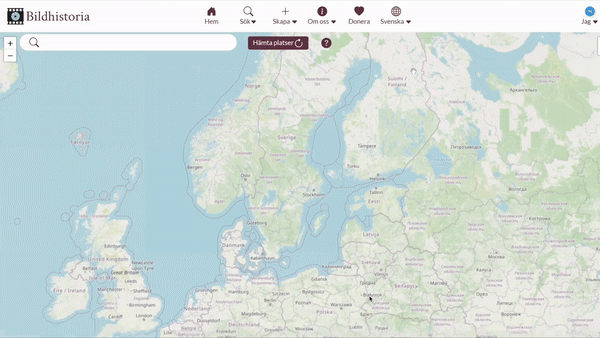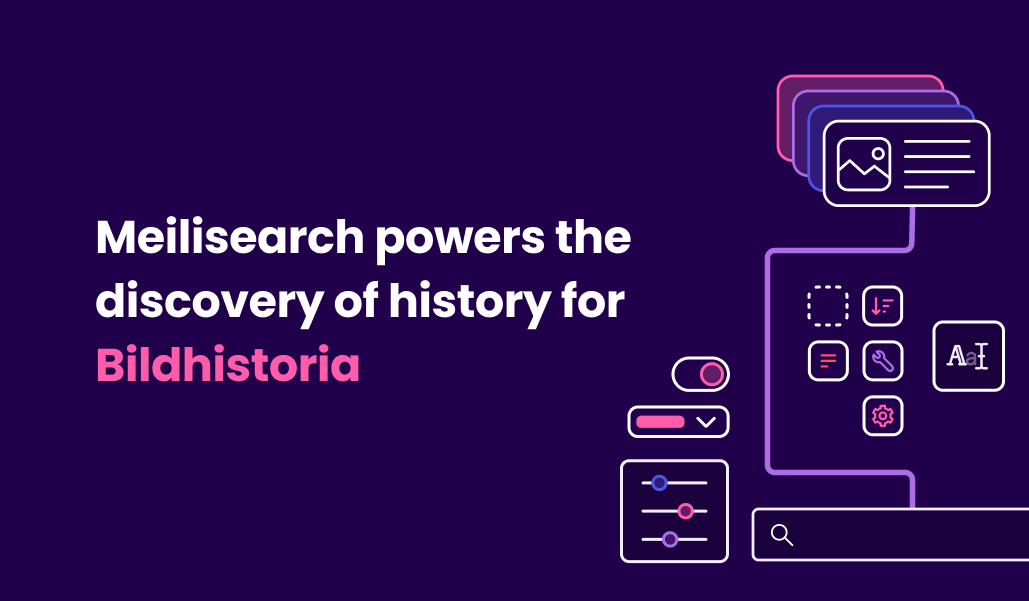Bildhistoria chose Meilisearch to power the search through its quickly growing database of historical photographs and affiliated data, driving the search from multiple sources of metadata and mapsearch.
“Bildhistoria's large volumes of historical photos, persons, places and organizations require a fast and easy to maintain search engine, like Meilisearch. Meilisearch is used on so many places around Bildhistoria, enabling our users to explore photos and learn more about ancestors and local history. This makes Meilisearch instrumental in the success of our community.” - Per Rohdin, board member of the community, and project manager at Bildhistoria.
Bildhistoria, a Swedish non-profit, operates the country's largest collection of copyright-free historical photographs. It focuses on collecting and preserving historical photographs from museums and private collections. While the project has not yet reached full general availability, Bildhistoria already boasts an impressive archive of around 90,000 images dating from the 1950s and earlier.
The project aims to create a dynamic and collaborative platform where the public can interact with history, and where professional and amateur genealogists alike can contribute by enriching the photographs with additional data.
Challenge: Bildhistoria tackles data fragmentation and community engagement
From the start, Bildhistoria faced three main challenges in bringing their vision to life:
Challenge: searching across multiple types of data: Bildhistoria's main challenge with search is effectively searching across the different data types. The platform features not only photographs but also information about people’s names, organizations, and locations associated with each image. The team needed a search solution that could seamlessly navigate through these different data types. To address this, they have implemented Meilisearch’s "multi-index search" that returns results from all the different indexes, allowing users to find relevant information regardless of whether they are searching for a person, place, or organization.
Challenge: data scattered across multiple sources: Historical photographs were scattered across various sources, including museums, archives, and private collections. There was no centralized platform in Sweden to consolidate these copyright-free images, making it difficult for researchers and the public to access this wealth of visual history.
Challenge: Community accessibility and engagement: Unlike traditional digital archives, Bildhistoria is an interactive platform where users can contribute additional historical facts and enrich the metadata associated with the photographs. The community of genealogists is large and diverse, spanning professional organizations to amateur genealogists and the general public. Bildhistoria’s team knew from the beginning that the only way to make the project work was to make it easily accessible and easy to use for everyone.
Solution: Bildhistoria chose Meilisearch for simplified operations, team-wide accessibility, and rapid data synchronization
After careful consideration, Bildhistoria chose Meilisearch as their search solution for several key reasons:
Less operational overhead: Meilisearch proved much easier to set up and connect to existing indexes compared to alternatives like Elasticsearch. This was crucial for a non-profit organization with limited resources.
Accessibility for all team members: Meilisearch's intuitive admin interface allowed even non-technical staff to understand and configure search settings. This democratization of the search configuration process was particularly valuable for fine-tuning Bildhistoria’s search experience.
Fast synchronization: Bildhistoria required efficient update mechanisms to keep Meilisearch indexes in sync with their database changes. Meilisearch's ability to handle rapid updates and re-indexing was crucial for maintaining an up-to-date and responsive search experience.
Implementation
Bildhistoria's implementation of Meilisearch involved several key steps:
- The team initially deployed the open-source version on Azure but faced challenges with the hosting environment.
- Bildhistoria team then switched to Meilisearch Cloud, which provided better management and support, allowing them to focus on their core mission rather than infrastructure concerns.
- Meilisearch was integrated throughout the platform, powering the main search functionality and an innovative map search feature.
- Finally, Bildhistoria invested significant effort in creating an efficient data synchronization pipeline between its database and Meilisearch to handle the constant flow of new information and user contributions.
Results
The implementation of Meilisearch has yielded impressive results for Bildhistoria:
Multi-index search: Users can now perform searches that capture results across various types of data—photographs, persons, organizations, and places. This holistic approach has dramatically improved the user experience, allowing for a more comprehensive exploration of historical connections.
Improved user experience: The search functionality provides alternative search suggestions for similar queries and provides rich context for each image.
Interactive map search: Meilisearch’s Geosearch allows users to explore photographs associated with specific locations in Sweden. As users interact with the map, new searches are performed in real-time, updating the displayed photographs.

Overall, the team noticed a significant improvement in engagement and user experience since the implementation of Meilisearch.
Conclusion: Meilisearch is a key part of Bildhistoria's vision for the future
Looking to the future, Bildhistoria has ambitious plans to further leverage Meilisearch to expand its platform's capabilities to become Sweden's leading platform for historical photographs. While initially focused on the Swedish market, Bildhistoria is open to European collaborations to scale the concept internationally. The next steps for improving the user experience on the platform would include:
- Integrate AI-driven facial recognition across photographs to link images of the same individuals across different time periods and locations.
- Add a houses and buildings index, enabling users to trace the lifecycle of specific structures through photographs.
- Implement features encouraging community collaboration, such as allowing premium users to follow and receive notifications about new edits and contributions.
- Scale operations to manage a vast archive of 1-3 million photographs by collaborating with more museums and institutions.
As the project progresses and reaches full production mode, Bildhistoria continues to assemble the right technical team to establish a sustainable and long-term setup for the community, laying the groundwork for its future growth and impact.

